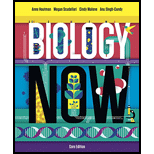
a.
To define:
What is the dividing line that lies between the macromolecules and the trace minerals according to the given graph?
Concept introduction:
The dietary minerals are of two types. Minerals that are needed in smaller amounts by the body is known as trace minerals. Some are iron, iodine, cobalt, copper, manganese, zinc, and fluoride. Minerals that are needed in larger amounts is known as macro minerals. Some macro minerals are calcium, phosphorous, sodium, chloride, magnesium, and sulfur.
b.
To define:
What does the y-axis show?
Concept introduction:
The dietary minerals are of two types. Minerals that are needed in smaller amounts by the body is known as trace minerals. Some are iron, iodine, cobalt, copper, manganese, zinc, and fluoride. Minerals that are needed in larger amounts is known as macro minerals. Some macro minerals are calcium, phosphorous, sodium, chloride, magnesium, and sulfur.
c.
To describe:
What is shown in the graph in own words.
Concept introduction:
The dietary minerals are of two types. Minerals that are needed in smaller amounts by the body is known as trace minerals. Some are iron, iodine, cobalt, copper, manganese, zinc, and fluoride. Minerals that are needed in larger amounts is known as macro minerals. Some macro minerals are calcium, phosphorous, sodium, chloride, magnesium, and sulfur.
d.
To define:
The quantity of potassium needed by an average person.
Concept introduction:
The dietary minerals are of two types. Minerals that are needed in smaller amounts by the body is known as trace minerals. Some are iron, iodine, cobalt, copper, manganese, zinc, and fluoride. Minerals that are needed in larger amounts is known as macro minerals. Some macro minerals are calcium, phosphorous, sodium, chloride, magnesium, and sulfur.
e.
To define:
Is the amount of potassium stated in the part (d) is the same amount that we need to eat daily.
Concept introduction:
The dietary minerals are of two types. Minerals that are needed in smaller amounts by the body is known as trace minerals. Some are iron, iodine, cobalt, copper, manganese, zinc, and fluoride. Minerals that are needed in larger amounts is known as macro minerals. Some macro minerals are calcium, phosphorous, sodium, chloride, magnesium, and sulfur.
Trending nowThis is a popular solution!

- Explain how the hormones of the glands listed below travel around the body to target organs and tissues : Pituitary gland Hypothalamus Thyroid Parathyroid Adrenal Pineal Pancreas(islets of langerhans) Gonads (testes and ovaries) Placentaarrow_forwardWhat are the functions of the hormones produced in the glands listed below: Pituitary gland Hypothalamus Thyroid Parathyroid Adrenal Pineal Pancreas(islets of langerhans) Gonads (testes and ovaries) Placentaarrow_forwardDescribe the hormones produced in the glands listed below: Pituitary gland Hypothalamus Thyroid Parathyroid Adrenal Pineal Pancreas(islets of langerhans) Gonads (testes and ovaries) Placentaarrow_forward
- Please help me calculate drug dosage from the following information: Patient weight: 35 pounds, so 15.9 kilograms (got this by dividing 35 pounds by 2.2 kilograms) Drug dose: 0.05mg/kg Drug concentration: 2mg/mLarrow_forwardA 25-year-old woman presents to the emergency department with a 2-day history of fever, chills, severe headache, and confusion. She recently returned from a trip to sub-Saharan Africa, where she did not take malaria prophylaxis. On examination, she is febrile (39.8°C/103.6°F) and hypotensive. Laboratory studies reveal hemoglobin of 8.0 g/dL, platelet count of 50,000/μL, and evidence of hemoglobinuria. A peripheral blood smear shows ring forms and banana-shaped gametocytes. Which of the following Plasmodium species is most likely responsible for her severe symptoms? A. Plasmodium vivax B. Plasmodium ovale C. Plasmodium malariae D. Plasmodium falciparumarrow_forwardStandard Concentration (caffeine) mg/L Absorbance Reading 10 0.322 20 0.697 40 1.535 60 2.520 80 3.100arrow_forward
- please draw in the answers, thank youarrow_forwarda. On this first grid, assume that the DNA and RNA templates are read left to right. DNA DNA mRNA codon tRNA anticodon polypeptide _strand strand C с A T G A U G C A TRP b. Now do this AGAIN assuming that the DNA and RNA templates are read right to left. DNA DNA strand strand C mRNA codon tRNA anticodon polypeptide 0 A T G A U G с A TRParrow_forwardplease answer all question below with the following answer choice, thank you!arrow_forward
 Human Anatomy & Physiology (11th Edition)BiologyISBN:9780134580999Author:Elaine N. Marieb, Katja N. HoehnPublisher:PEARSON
Human Anatomy & Physiology (11th Edition)BiologyISBN:9780134580999Author:Elaine N. Marieb, Katja N. HoehnPublisher:PEARSON Biology 2eBiologyISBN:9781947172517Author:Matthew Douglas, Jung Choi, Mary Ann ClarkPublisher:OpenStax
Biology 2eBiologyISBN:9781947172517Author:Matthew Douglas, Jung Choi, Mary Ann ClarkPublisher:OpenStax Anatomy & PhysiologyBiologyISBN:9781259398629Author:McKinley, Michael P., O'loughlin, Valerie Dean, Bidle, Theresa StouterPublisher:Mcgraw Hill Education,
Anatomy & PhysiologyBiologyISBN:9781259398629Author:McKinley, Michael P., O'loughlin, Valerie Dean, Bidle, Theresa StouterPublisher:Mcgraw Hill Education, Molecular Biology of the Cell (Sixth Edition)BiologyISBN:9780815344322Author:Bruce Alberts, Alexander D. Johnson, Julian Lewis, David Morgan, Martin Raff, Keith Roberts, Peter WalterPublisher:W. W. Norton & Company
Molecular Biology of the Cell (Sixth Edition)BiologyISBN:9780815344322Author:Bruce Alberts, Alexander D. Johnson, Julian Lewis, David Morgan, Martin Raff, Keith Roberts, Peter WalterPublisher:W. W. Norton & Company Laboratory Manual For Human Anatomy & PhysiologyBiologyISBN:9781260159363Author:Martin, Terry R., Prentice-craver, CynthiaPublisher:McGraw-Hill Publishing Co.
Laboratory Manual For Human Anatomy & PhysiologyBiologyISBN:9781260159363Author:Martin, Terry R., Prentice-craver, CynthiaPublisher:McGraw-Hill Publishing Co. Inquiry Into Life (16th Edition)BiologyISBN:9781260231700Author:Sylvia S. Mader, Michael WindelspechtPublisher:McGraw Hill Education
Inquiry Into Life (16th Edition)BiologyISBN:9781260231700Author:Sylvia S. Mader, Michael WindelspechtPublisher:McGraw Hill Education





